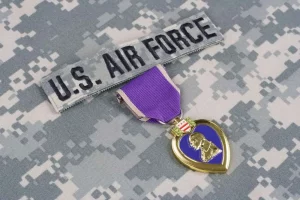
For those who work with the United States Department of the Air Force, their awards and decorations were first issued in 1947 – the year when airmen were then eligible to receive most of the U.S. Army’s decorations.
By 1962 – the year immediately following the Cuban Missile Crisis – the Department of the Air Force decided to begin issuing its own awards that were distinct and separate from the U.S Army.
When participants are first involved in Basic Military Training, they have the ability to earn up to four ribbons upon graduation.
The first two ribbons that they are eligible to earn are automatic if they graduate as an airman in the United States Air Force – these two ribbons are known as the National Defense Service Ribbon and the Air Force Basic Military Training Ribbon.
For those interested, here is what you need to know about authentic air force ribbons that are associated with basic training in the Air Force.
Air Force Training Ribbon
For those that meet the standards of Air Force Basic Military Training and proceed to graduate, they are able to receive the AFBMT Ribbon.
The Air Force Training Ribbon – which was first awarded after August 14, 1974, and then first authorized by the Air Force Chief of Staff on Oct.12, 1980 – is granted to those who graduated from Air Force basic training.
By December 1986, the criteria to earn the ribbon was expanded to include anyone who was on active duty regardless of whether they had completed their initial accession training.
At this time, it was also agreed upon that if one was promoted to the officer ranks after another round of basic military and accession training; then they would then be able to receive an additional award that was differentiated by an oak leaf cluster.
National Defense Service
Once members meet the standards required and graduate from Air Force Basic Military Training, they are then entitled to receive the National Defense Ribbon.
Members can also receive the National Defense Service Medal if they complete honorable active duty service – but only if they complete this service during the time that has been allocated by the President.
According to the historical record, the National Defense Service Medal – considered the oldest service medal in use in the United States – was first established on April 22, 1953, by President Dwight D. Eisenhower and was initially intended for those who were eligible members of the Armed Forces and performed their duties between 1950 and 1954.
This would change during Vietnam and the Gulf War when the President decided to issue the medal to all the members of the Armed Forces.
After 9/11, eligibility was expanded even further to include service members who had honorably served during a period of national emergency or war or were granted the medal at the discretion of the Secretary of Defense.
Basic Training Honor Graduate Ribbon
Those who are instead awarded the Basic Training Honor Graduate Ribbon are asked to wear it if they are selected as an honor graduate.
The ribbon was first authorized on April 3, 1976, by the Chief of Staff and is given to a graduate who has met all the phases of academic and military training and is considered within the top 10 percent of their training cohort.
Small Arms Marksmanship Ribbon
The other ribbon to consider – the Small Arms Marksmanship Ribbon – is given to those who receive an expert score that they achieved while using the M-4 carbine rifle on the firing range. This program has been issued since 1963.
Receiving an expert score entails earning a single bronze star for both the rifle and handgun categories. To earn the expert qualification, a student will need to attain 43 hits out of 50 rounds while simulating targets (all of which are 25 meters and also include simulating targets at 50 meters to 300 meters) away at different ranges.
In total, the student will need to fire ten shots from the positions of standing-barricaded, kneeling-barricaded, and prone-unsupported. They then each fire 20 more shots from the prone-supported position.
Of those additional twenty shots, ten are fired while the student is wearing a gas mask. In addition to performing in this manner, another way to receive the Small Arms Marksmanship Ribbon is to complete the Air Force Combat Rifle Program.
Since September 11, 2001 – the 9/11 attacks – Air Force Basic Military Training has been upgraded to include changes to the fitness standards, shooting standards, and overall academics.
These changes have been made in order to create a group of airmen who are far more prepared for battle. With this additional training, the airmen of the 21st century have a lot more training to deal with the new and highly technological warfare (which includes much more precision and attention to detail) that they will be encountering.




















